Adria Fischer, then Director of Customer Marketing at Sovos, made this presentation at the Customer Marketing Summit in September 2021. Watch presentations OnDemand now.
My name’s Adria Fischer and I'm the Director of Customer Marketing at Sovos, a leader in the tax and regulatory compliance industry.
We’re a global company specializing in solutions for the complexities of digital tax transformation, with complete and connected offerings for tax determination, continuous transaction control, tax reporting, and more.
I've been working in marketing for over 15 years, and I've had the good fortune to work at some great companies including Time Warner Cable, Comcast, WGBH, as well as Kronos, which is now UKG before joining Sovos, half a year ago.
So, I've held a variety of roles in marketing, including program management, customer reference management, competitive intelligence, and product marketing before joining the ranks of customer marketing about four years ago. That said, I found my place when I entered the world of customer marketing.
It's been a wonderful journey for my career so far, and I'm loving the growth that's happening in this field, as there are so many opportunities.
It’s a really exciting time for anybody who wants to learn more or pursue this area, and this session emphasizes that the key to engaging customers is an investment in developing robust and dynamic customer personas, specifically focusing on how your personas interact with your business, your product or your service, as well as how they engage, knowing what they need, and more importantly, why they matter.
What is the role of a customer marketer?
I believe the role of the customer marketer is to gather insights and extrapolate why each persona matters. After all, every persona matters, whether they’re an end-user or a decision-maker.
Continuously researching, interviewing, and validating your personas is essential to developing meaningful and relevant multi-channel content. It also ensures that the content you create is going to resonate, and that you're delivering the right message to the right person at the right time using the right tactics.
One of the first projects I undertook when I transitioned to customer marketing was developing my company's customer personas. I didn't know it at the time, but it would become a pivotal project in my career. As time went by, my name became increasingly associated with customer persona work that I'd done; I was often brought into conversations to provide guidance on how to use them, and also approached by other customer-facing teams who wanted to learn more.
Ultimately, I was called in as the SME (Subject Matter Expert) when it came to the organization's customer personas. Doing the research and analysis to develop the customer personas laid the groundwork for validating future decisions around release readiness, events, strategies, and many other programs.
A solid understanding of the customer personas enabled my team to create segmented programs and more tailored learning paths and user events, which provided greater value and more relevant content.
In this article, I’ll focus on:
- What personas are,
- The difference between user and buyer personas,
- How to keep your personas current, and
- Persona mapping.
What is a persona?
A persona is defined as a fictional character created to represent a user type that might use a site, brand, or product in a similar way.
Personas are used to consider the goals, desires, and limitations of buyers and users to help guide decisions about a business's service, product, or interaction. Put simply, the purpose of any persona, whether this is buyer or customer personas, is to help you understand a particular personas needs, experiences, behaviors, and goals.
I’m also an advocate of making the distinction between all three types of personas within your organization because they each serve their own purpose. Buyer personas are going to be focused on pain points, or daily frustrations and challenges, as well as what type of information they lean on during the buying process.
Additionally, they’re also an important tool for how to effectively position your solution or service during the buying stage of the life cycle. Moreover, when a supplier purchases the product or service, they become a customer.
How are user and customer personas different?
I've often seen confusion around user and customer personas; after all, the customer uses the solution or service, so why would they not simply be a user persona?
Generally, user personas are created by user experience or user research teams for design and engineering purposes. On the other hand, customer personas are a tool that should be created and used by marketing, specifically customer marketing.
User personas as created by a user experience team often get into demographic details like age, type of employment level of education, income, hobbies, interests, etc. As one Director of UX explained to me years ago, the details matter for user personas because they're a tool for engineers, who may benefit from a better understanding of the person who is going to be on the receiving end of their coding and design.
In simple terms, user personas are a means to humanize why feature X matters, or why button A should be located where it is.
We also have customer personas, and these focus on how customers interact with the solution, the product, or even the business, as well as how they engage, what they need, and most importantly, why they matter to your company or organization.
Finally, customer personas matter because a lot of customer marketing is focused on communicating the right information, to the right person, at the right time, in the right way.
To share relevant information with the appropriate audience, we need to first identify who that audience is, what information they need to consume, why they need to consume it, and the correct time to communicate that information to them.
Customer personas help us align the appropriate information with the correct person, so communications and content are meaningful, tailored, and timely.
How to keep your personas current
Well-developed personas are foundational for creating segmented and personalized communications, programs, and content that resonate and are impactful.
Let's assume I've convinced you to develop and create customer personas. Perhaps you've been using the buyer personas product marketing created, or the user personas someone handed you when you first joined customer marketing, and within the last few minutes, you slammed your fist down and said, “no more not gonna stand for this. I need the right tools to be the best customer marketer I can be. I'm going to start by developing a set of customer personas.”
Generally speaking, there are four steps to get started as with any project:
- Identify,
- Research
- Analyze, then
- Turn your work into a usable tool.
I'm going to give you some tips on how you can keep your customer personas current and become a priority for your organization, and a key component during planning.
1) Identify your customer personas
If you're starting from scratch, I recommend partnering with someone on your operations team who has access to your customer database and knows how to create or pull reports. It’s even better if they're an Excel wizard and can help you categorize and segment the various data points.
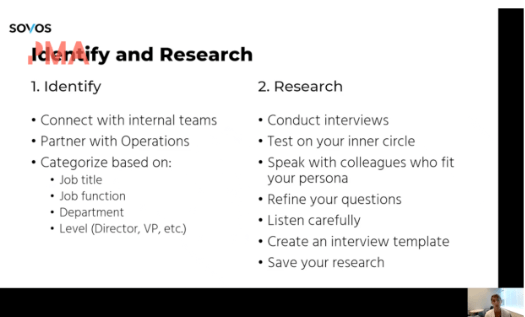
A good place to start is pulling data based on job titles, functions, or departments. It’s also useful to have a conversation with your sales engineers or your sales teams to find out who they present to during demonstrations.
Sales engineers or pre-sales often use demo scripts based on which role and user type they're presenting to during the buying cycle. This team is a great resource to better understand which departments and job functions matter after that buying decision to see the buying decision stage.
Another good starting place is to pull together all the personas that exist across your organization including buyer and user personas.
From there, you can categorize and start identifying, it's equally important to look for the gaps. It's possible that there's a persona that hasn't been accounted for because they only interact with one department, or they’re perhaps only involved in one stage of the life cycle.
Additionally, you might find that you've identified some personas that are overlaid. At my last company, we had a persona that one of my colleagues coined ‘the data ninja’.
This was a persona that could have been just as easily a manager or an administrator for the system, or even a decision-maker, it was all about somebody who just loved data and reporting and had very little to do with what their day to day role was and how they interacted with the solution or the business.
2) Conduct research
Step two is research. By this time, you should have a good idea of how many personas you have as well as who your customer personas are - but what do you know about them? You need to do the research to understand your personas in greater detail, and interviewing is a great way to do this.
Start by listing all the questions you want to ask. For example, when I’ve done interviews with customers at Sovos, these are some of the questions that I start with:
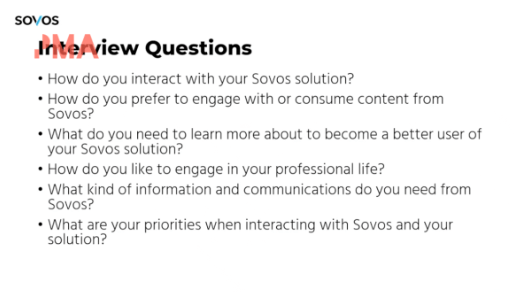
If your list of interview questions adds up to twenty or more, it's a good idea to start with a person you know will be receptive to answering a long list of questions. If you can find one of your personas within your organization or your inner personal circle, this is a perfect entry point to formulate and test your interview questions.
Moreover, starting with peers or colleagues helps you refine that list of interview questions. It’s better to learn which questions don't garner that much information or even feel redundant with a person who's going to be patient with you, rather than a customer whose time you might want to use more wisely.
For example, in my last role, we’d identified the IT administrator as one of the customer personas. I happen to be married to a person who has worked in IT his entire career, so I approached him to be my first interviewee. The interview helped me figure out the best way to phrase questions to gather the most insight and information.
I also reached out to coworkers who worked in the same departments as our customer personas.
For example, if your customer is in payroll, HR, finance, or the legal department, there's a good chance you have a colleague you can interview. The likelihood is they'll give you a lot of great information and insight because it might be one of the few times someone's coming to ask them:
- What do they want to know about from their vendors?
- What information do they want to receive?
Here are some additional words of wisdom from my college journalism professor:
“Never underestimate the power of being silent during an interview.”
Interviews are about the person you seek information from and are an opportunity for them to share their story and experience, so listen carefully and let them speak.
Resist the urge to complete their sentence or finish their thought or even jump in when they pause. A pause just means they want to give you the most thoughtful response possible. I also highly recommend creating an interview template, so you're consistent with each interview.
If others on your team are handling interviews, everyone is working off of the same script. You're also going to want to save your interview notes in a shared repository or some type of folder. Trust me when I tell you that you'll want to reference them from time to time.
3) Analyze
By the end of step one, you have the shell or skeleton of your persona, and now it's time to start adding the guts - having multiple complete interviews for each persona is going to be critical to creating thoughtful and comprehensive analysis.
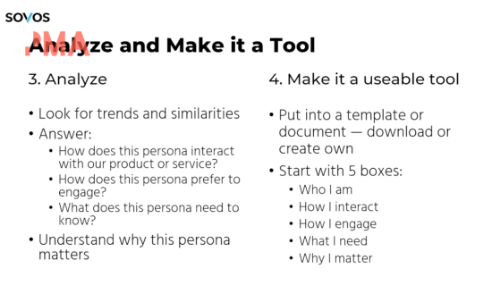
During your interviews, you're going to start seeing trends and similarities for how your distinct customer personas interact with your products or services:
- How do they prefer to receive and can consume information?
- What kind of information do they care about?
Therefore, you'll have well-developed personas and distinct customer personas when you can answer these three questions:
- How does this persona interact with our product or solution?
- How does this persona prefer to engage with us?
- What does this persona need to know?
If you can answer all of those questions, you're on your way to knowing and understanding why that persona matters.
4) Make it a useable tool
Step four is to convert your research and analysis into a tool you can reference and make your customer personas tangible.
Give them the same treatment that's been given to your buyer and user personas in terms of presentation quality, and using a visually appealing and well-organized template.
The first document I created for our customer personas help five boxes:
- Who I am,
- How I interact,
- How I engage,
- What I need, and
- Why I matter.
You can find templates galore with a search on the web or partner with your creative team to create a unique PowerPoint template.
For customer personas, it's always been my preference to not add a picture. I believe that customer personas are representative of hundreds, thousands, perhaps even millions of persons, and you need to care about what's on the inside and how they interact with your solution. Limiting your persona to a single face or gender may create unintentional bias.
Here’s an example of a really basic template that addresses those key components:
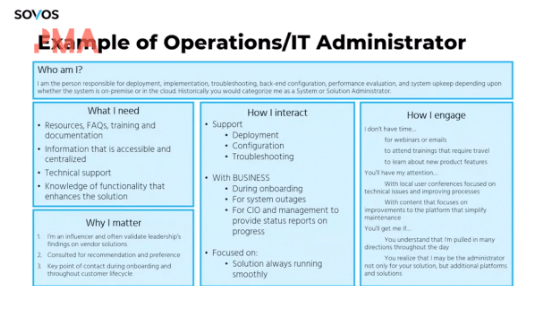
Persona mapping
- Start by identifying your customer personas,
- Research your personas using interviews,
- Analyze your findings to start building out your personas, then
- Turn your work into a tool that can be used by you, your team, or even better the customer-facing teams at your company.
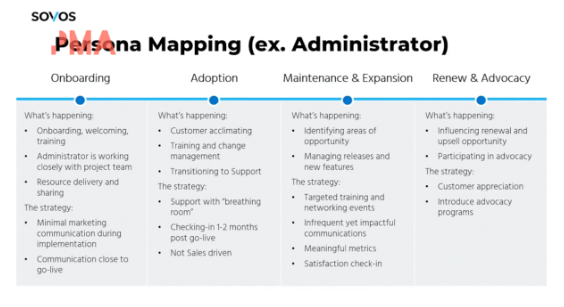
With your customer personas developed, the next step is to map them along the customer journey or life cycle.
To begin mapping, you need to know what's happening in each stage or phase, then the real value of the customer persona work takes focus because your research and your deep knowledge of the customer personas will make you an expert for knowing where each of your personas is involved, and more importantly, how they're involved.
It takes an understanding of what's happening to each persona across the lifecycle to create compelling persona-based messaging and engagement programs. I highly recommend going through the journey mapping exercise one persona at a time.
For example, the chart above is an example of persona mapping for an administrator persona. Everything I know about how the administrator persona is involved in what's happening for that persona is through research and interviews.
It's after the clear understanding of what's happening and what needs to be communicated to that persona during that lifecycle stage that you can begin to determine and strategize how to best engage and how to best engage them. For me, that's the fun part, so let's take this a step further.
During the onboarding stage, one of your touchpoints is a welcome message to your new customers to express excitement and enthusiasm with optimism for a successful partnership.
With your customer persona work mapped to the customer lifecycle, you know both the decision-maker and administrator can play a role during onboarding. How you engage and what you communicate to those personas is likely to differ significantly.
The welcome message for the decision-maker may emphasize the trust that was built during the buying and consideration stage. You may also know your decision-maker is likely to be at an executive level and not directly involved in the implementation of the product or solution. In that case, a personal letter from the VP of Sales or General Manager is an appropriate tactic.
On the other hand, your administrator persona is going to play a critical role during implementation and throughout onboarding. You need to set expectations with an overview of the project timeline, project resources to get the project team ready or present a checklist of things to do in advance to get that first project kickoff meeting ready.
Embedding customer personas into your customer lifecycle is how you go from good to great. It's one thing to understand the touchpoints that are imperative throughout the journey, to understand the value and importance of knowing which customer personas fit into the various stages along the lifecycle; you need to communicate to them effectively to deliver your desired message.
This is how you become great. Taking it to that level of detail ensures that you are sending the right message, to the right person, at the right time, and in the right way. From here, you can focus on how to engage your personas.
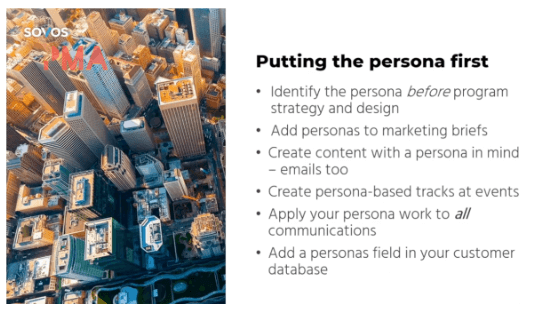
The more you know about your personas and what makes them tick, the more capable you become of delivering a great experience. You'll be able to elevate the moments that matter and the milestones that mean something to them.
Knowing what matters to your personas, and how they prefer to be engaged is critical as it helps determine the elements and tactics for your customer programs, as well as where to allocate budget and resources.
The ‘How’ can be a fun process too, where any idea is discussed, new ideas are explored, and discussions of new ways to present information are brainstormed.
Additionally, it's not just about your product or service. When you prioritize personas as part of your customer marketing, engagement, planning, and strategy, you become better positioned to recognize, acknowledge, and celebrate significant yet sometimes elusive key moments that delight your customers.
Whether it's an obscure holiday that only that persona might know about, or an event that's specific to that persona, or just knowing that being thanked and appreciated during a busy time of year or a certain time of year is how you make a difference and become memorable.
In summary
Make persona marketing a priority by putting it as the first step when you begin your planning processes and identify the intended persona before you plan, strategize, or design a program, campaign, or event.
Also, be sure to add personas as a field to your marketing brief so your content briefs and design communications are created with a specific persona in mind.
It’s also beneficial to partner with other customer-facing teams to develop a communication strategy that is centered on the persona.
Even better, work with your operations team to embed personas as a field in your customer database. This makes creating segmented lists infinitely easier when you want to send a communication directly to that persona, and your hard work shouldn't be left to sit on a shelf gathering dust.
Always keep your personas current with continuous research and interviews. You can do this by creating a goal to conduct a certain number of interviews, possibly even making it a quarterly goal, and then you're going to want to validate your hypotheses to ensure you're hitting the mark with each persona.
For example, does one form of communication perform better than another? Do you receive higher response rates during a certain time of year, day or week?
Be sure to update your research and documentation routinely so your personas stay relevant and current.




